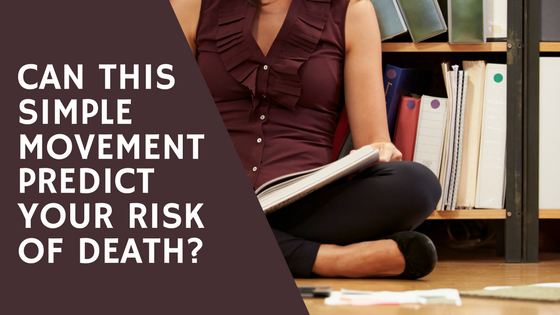Can This Simple Movement Predict Your Risk of Death?
When you go to see a doctor for your annual physical, you are there for 2 main reasons:
- To identify any disease processes that may be hiding underneath the surface so that a potentially deadly illness can be caught and treated early (cancer, heart disease, brain illness, etc)
- To have routine tests done that can help you gauge your overall level of health and fitness to prevent chronic illness (pulse, blood pressure, blood sugar, cholesterol, etc)
These routine exams and tests are generally unremarkable while we are young and healthy, but they become a lot more meaningful as we age, and our risk for illness increases. When we think about your risk of death, we generally think about our blood pressure, cholesterol, and blood sugar numbers.
All of those numbers are important, and certainly help predict your risk of dying from cardiovascular and metabolic disorders in the future. However, one of the things we see in the aging population is a gross loss of mobility and strength. You can see it in the way that many older people move. Walking is slow and cautious. Bending and picking up things from the floor become an extraordinary challenge.
From an evolutionary perspective, a lack of mobility and fitness can drastically affect your survival value. While elder adults can be wise and crafty in their survival skills, this lack of fitness can make you less likely to catch/produce food, escape danger, and become a burden on a migrating group of hunter gatherers.
But does that still carry over into today’s world where we aren’t being chased by tigers or migrating across a continent? The scientific eviduce seems to say yes. Strength and cardiovascular fitness have repeatedly been shown to be protective from your risk of death from all causes. [Source 1, Source 2]
Movement and Strength Are Signs of an Efficient Nervous System
Movement and strength are important markers to the functionality of the nervous system. Remember that your brain is built to move your body to acquire and maintain resources for survival. When we examine people neurologically we are looking at things like their posture, balance, gait, and muscle strength because it gives us an idea about the functionality of their brain.
Just think about what happens with things like MS, Parkinson’s Disease, and stroke. They affect our ability to move, but they are not strictly a muscular problem we are looking at. They are brain problems!
To put it simply, if you can’t perform some of the basic movements of a human being, it suggests that there are deficiencies within the brain.
Sitting/Rising Test (SRT)
In 2014 the European Journal of Preventive Cardiology published a study that suggests that a simple movement test can predict risk of death in middle aged and elderly individuals.
2076 people were studied between the ages of 51-80 and were tracked from 1997 – 2011. Subjects performed a test called the Sitting/Rising Test(SRT). The test is really simple. The subject sits on their bottom and stands up and are asked to perform the test without using their hands, knees, or sturdy objects. Each time that a hand, knee, or assistance is used, a point is given. The total points are subtracted from 10 and an overall score is assigned.
Check out the infographic below:

Image Credit http://www.easternhealth.sg/Pages/NewsDetails.aspx?ProjectID=1649
Having a score of 8-10 is associated with a high protection from death of all causes regardless of age, sex, or body mass index. Every point below was associated with a 20% increase in death from all causes within the next 6 years. A score of 4 or more generally meant you could function independently, while less than that indicates a need for assistance.
What It Doesn’t Mean
So here’s the thing. This test correlates with your risk of death, there is no causation behind this and dying. The fact that you can’t do this exam well doesn’t mean you’re going to die from some horrible illness. It also doesn’t mean that simply practicing this test so that you can do it well is going to magically decrease your risk of death. We are looking at correlations not causations here.
This test is a functional indicator of your strength and basic neurologic fitness. Being able to do this means that your muscles have appropriate strength to move your body through space, and that your brain has good control of your body movements. It’s an indicator that you are fit and have good enough balance to not hurt yourself.
Rather than focusing on practicing this movement, you should be focusing on getting stronger and having better body balance. It means that maybe you should add some weight training to your weekly routine 3 times per week. It means maybe you should take a conscious movement practice like yoga or Tai Chi to improve your balance.
Remember, you’re not doing these things to prevent death. You are doing these things because it helps you to navigate through the challenging parts of life that much easier.






Thank you for sharing, I really enjoyed this post! I recommend my older patients to always remain active, even if they are in immense pain.